Lancelot/Discover Lancelot/it: Difference between revisions
(Importing a new version from external source) |
(Importing a new version from external source) |
||
| Line 61: | Line 61: | ||
'''Lancelot''' fornisce tutte le funzionalità di ricerca che ha [[Special:myLanguage/KRunner|KRunner]]. Puoi utilizzarlo per trovare applicazioni, per fare calcoli, eseguire comandi BASH, come convertitore d'unità ecc. Per maggior dettagli vedi [[Special:myLanguage/Plasma/Krunner|Utilizzo di KRunner]]. | '''Lancelot''' fornisce tutte le funzionalità di ricerca che ha [[Special:myLanguage/KRunner|KRunner]]. Puoi utilizzarlo per trovare applicazioni, per fare calcoli, eseguire comandi BASH, come convertitore d'unità ecc. Per maggior dettagli vedi [[Special:myLanguage/Plasma/Krunner|Utilizzo di KRunner]]. | ||
=== | === Navigazione da tastiera === | ||
If you don't like to use the mouse, every part of '''Lancelot''' can be accessed via keyboard. | If you don't like to use the mouse, every part of '''Lancelot''' can be accessed via keyboard. | ||
Revision as of 18:56, 29 December 2010
La prima sezione ti conduce in un giro guidato su Lancelot. La seconda è dedicata ad opzioni e concetti più avanzati.
Informazioni generali
Introduzione
Lancelot è un menu per il lancio di applicazioni per la KDE Software Compilation.
Lancelot o Kickoff?
Lancelot fornisce molte funzioni ed opzioni di configurazione che Kickoff non ha. Per un confronto più dettagliato vedi il confronto con altri lanciatori.
Kickoff è il menu predefinito per il lancio delle applicazioni per la KDE SC. Per sostituire Kickoff con Lancelot, devi aggiungere quest'ultimo tramite il pannello 'aggiungi oggetti'. Per maggiori informazioni su come aggiungere e rimuovere oggetti dal pannello, vedi Come fare per...con Plasma.
Lancelot o KRunner?
Lancelot può essere utilizzato come sostituto di KRunner. Vedi il confronto con altri lanciatori per un elenco dei vantaggi.
In modo predefinito Lancelot può essere aperto tramite la scorciatoia Alt + F5 (può essere modificata).
Uso di base
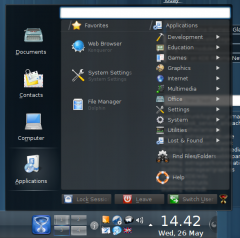 |
Lancelot con le impostazioni predefinite |
Quando farai clic sull'icona di lancio che hai aggiunto al pannello, si aprirà il menu Lancelot.
Mostra quattro sezioni: , , e .
Sezioni
Applicazioni
La sezione Applicazioni contiene un elenco delle tue applicazioni preferite nella colonna a sinistra e le categorie delle applicazioni in quella a destra. Se l'applicazione che stai cercando non è nell'elenco delle Preferite, puoi navigare tra le categorie sulla destra semplicemente selezionandone una
Quando ti immergi nelle categorie, la sezione Preferiti scompare per dare più spazio alla navigazione. Puoi sempre tornarci utilizzando la barra breadcrumb in alto.
Computer
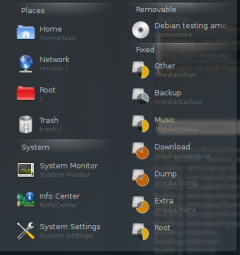 |
La sezione Computer di Lancelot |
La sezione Computer contiene un elenco di risorse predefinite (come si è visto in Dolphin), alcune utili applicazioni di sistema e un elenco di dispositivi di memorizzazione.
Puoi espellere/montare/smontare i dispositivi rimovibili direttamente dal menu semplicemente facendo un clic destro su quello desiderato e scegliendo l'opzione giusta dal menu contestuale.
Contatti
La sezione Contatti mostra l'elenco dei messaggi di posta non letti da Akonadi (KMail) e dei contatti in linea da Kopete.
Documenti
La sezione Documenti mostra un elenco delle applicazioni da ufficio sulla sinistra e un elenco dei documenti attualmente e recentemente aperti sulla destra.
Capacità di fare ricerche
Lancelot fornisce tutte le funzionalità di ricerca che ha KRunner. Puoi utilizzarlo per trovare applicazioni, per fare calcoli, eseguire comandi BASH, come convertitore d'unità ecc. Per maggior dettagli vedi Utilizzo di KRunner.
If you don't like to use the mouse, every part of Lancelot can be accessed via keyboard.
| Action | Key | Description |
|---|---|---|
| Switch sections one by one | Page Up and Page Down | Shows previous and next section respectively |
| Switch to the specific section | Alt + number | Alt + 1 for Applications, Alt + 2 for Computer... |
| Activating items | Alt + letter | If an item has a letter underlined in its title, it can be activated by pressing together Alt and that letter |
| Moving through list items | Up and Down keys | |
| Moving between columns | Left and Right keys | |
| Activating the selected item | Enter | If no item is selected, the first search result is executed |
| Opening context menu for the selected item | Alt + Enter | |
| Search box completion | Tab and End; Left and Right keys | Tab and End keys use the whole suggestion while Left and Right move through the suggestion. |
More advanced topics
Advanced UI concepts
No-click activation
In order to reduce repetitive strain injuries produced by clicking the mouse buttons, Lancelot can be operated, if desired, without a single click.
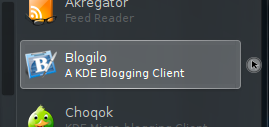
When you hover an item in the menu, a small icon that looks like a target with a mouse cursor drawn in it will appear. Instead of clicking, you can just hover the icon (or the area near it) and the item will be automatically activated.
Adaptive layout
The layout of the menu differs depending on the position of the applet which invoked it.
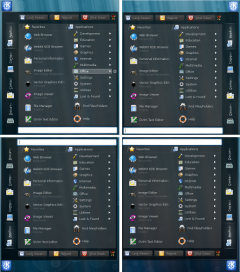
Always, the closest to the invoking applet (and the mouse cursor) are the section and system buttons, and the search box is on the opposite side since it has the focus by default and you don't need to click it in order to use it.
The sections are also reordered so that the Applications section is the closest to the mouse cursor.
Adaptive item sizes
The less items a list has, the larger the items and bigger the area for clicking.
When there are more items, Lancelot tries to show them all at once by reducing the size. If there are too many items to be shown all at once, the scrollbars are used as a solution.
Show sections inside the applet
If you think that the section buttons are too big and would be better if placed inside the panel itself, just right-click the applet, choose and .
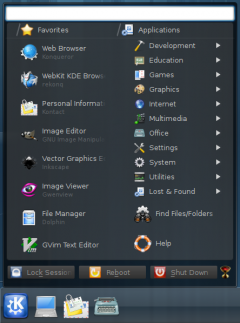
Show smaller section buttons
If you think that the section buttons are too big, but you don't want to place them inside the panel, just right-click them and choose .
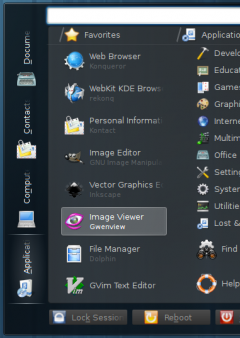
Custom system actions
If you don't use session switching (the 'switch user' feature), you can set different actions to the buttons in the bottom part of the window via the tab of the Lancelot's configuration dialogue.
Custom applications
You can choose which applications to show in the Documents and System sections via the tab of the Lancelot configuration dialogue.
Reordering items
You can change the order of favourite applications just by drag and drop. Mind that for it to work, you need to unlock your desktop first.
Some users prefer that the applications subcategories open in separate popups like they are used to from the classic menu from KDE 3. Since KDE SC 4.5, a new experimental feature was added to Lancelot which enables this behaviour.
To enable it, check the option in the tab of Lancelot's configuration dialogue.
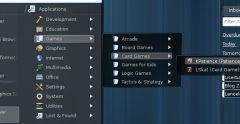
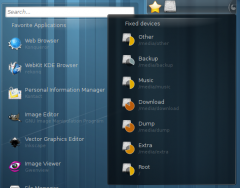
It is useful to have things that you use often placed on the desktop or the panel. For more info, see using the Shelf applet
